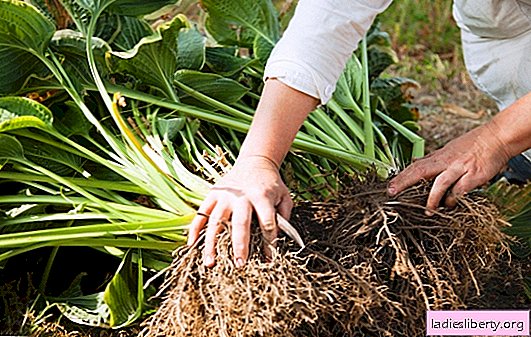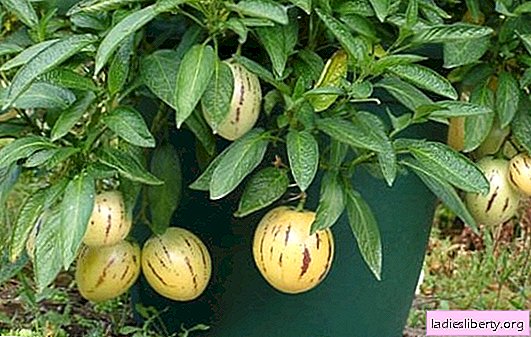
Perennial host belongs to the family of liliaceae. The plant gained its popularity due to the large and dense leaves. In some species, they are especially decorative. In landscape design, the host wins among other representatives of the flora. It goes well with trees and shrubs, annual and perennial flowers. The host belongs to unpretentious varieties, but some issues should be considered when planting and transplanting it.
What you need to know when landing hosts
Although the flower is undemanding in care, there are some things to keep in mind when planting it:
• hosta tolerates winters well, suitable for growing in the middle lane;
• easily copes with heat, but requires shaded places;
• most species do not tolerate direct sunlight;
• the planting period of some varieties is too short, do not delay the work.
Hosting Autumn Dates
Plant transplants are carried out quite rarely, this is due to difficult adaptation in a new place. Hosta loses decorativeness, for a long time increases sheet mass. The plant is transplanted only in case of emergency: the perennial is very thickened, it is necessary to save the plant from the disease, the need arose for propagation of this species.
The transplant is planned in advance. Optimal is the hosta landing in the spring, but not for all varieties it is suitable. For example, the host of Siebold and Tokudam is transplanted only in the fall. This is due to the peculiarity of the root system of the plant.
When to transplant the host in the fall? If such a need arose, then you need to remember the timing of landing. You need to start work at the very beginning of autumn. In each region, the timing is different. In the middle lane, host transplantation from the beginning of August to the end of September is considered optimal. This is due to the early cold weather. The adaptation of the plant takes about 1 month. You need to remember this when choosing a time for a host transplant in the fall.
How to start a host transplant in the fall?
Work begins with the preparation of the site. Despite the fact that the host will grow on any soil, planting should be avoided in swampy and damp ground. Clay soil is especially bad for the condition of the flower. The best solution for growing hosts is a light, nutritious substrate.
Soil preparation includes a number of measures aimed at improving its structure.
1. Before planting, you need to dig the ground, choose the rhizomes of all weeds.
2. If the soil on the site is sandy, then peat is made for digging.
3. Improve the heavy soil will help river sand, which is added for digging.
4. Too poor soils enrich with mineral fertilizers or ash.
The landing site is chosen in the shade of trees or other perennials. A few hours before the planned transplant, the flower bed is well watered. Experienced gardeners advise adding several crystals of potassium permanganate to the water.
How to spend an autumn transplant hosts + photo
The process of transplantation begins with the complete digging of the bush. Next, the roots need to be freed from the old earth and washed. Having carefully examined the root system, all damaged branches are cut out.
When transplanting, the plant is rejuvenated. To do this, the ends of the roots can be cut with a sharp secateurs. Further, the mother bush is divided into plots, for the convenience of using a tool. All sections and fault locations must be dusted with ash or treated with fungicides.

Landing pit is prepared in advance. At the bottom of the hole, drainage of broken bricks, shards or gravel is laid. Fallen leaves or humus are poured over the drainage layer. The seedling is lowered into the hole and sprinkled with earth. During a hosta transplant in the fall, the root neck of the plant should be level with the ground. In the future, it is mulched with humus.
If you plan to plant several plants, then you can not forget about the impressive size of an adult bush. Between the seedlings leave enough space for their development. The optimum is the interval between plants up to 1 meter.
How to prepare your host for winter
After the fall transplant, the host needs additional care. If the weather is warm, it is necessary to water the plants, not allowing the earth to dry out. Special attention deserves the preparation of hosts for the winter.
In regions with a warm climate, the host does not need any special procedures. Before the onset of cold weather, the flower is mulched with sawdust, peat or hay. But in the middle and northern strip after transplanting, the shrub can die. Therefore, measures must be taken to protect the plant.
1. The host needs pruning. In the fall, after transplanting hosts, old peduncles are cut. So the plant does not spend energy on ripening seeds.
2. Leaves of a bush do not cut. Drying, they serve as a natural mulch.
3. Before the onset of cold weather, the shrub is dug up and mulched with sawdust, peat, dry leaves.
4. Further, the plant is well watered with Fitosporin or sprinkled with tobacco dust. This is necessary in order to scare off snails in early spring.
Important! Hosts do not use film or other airtight materials for shelter. This leads to decay of the plant.
Despite the fact that many gardeners are inclined to the advice not to prune hosta leaves for the winter, seasoned summer residents advise the opposite. Whether or not to do this is up to you. If the flower bed with the hosts is large, then you can conduct an experiment by cutting off part of the plants.
• Hosta pruning leaves in the fall, after their complete yellowing, but before frost.
However, it is difficult for a novice gardener to choose the right moment, so before you trim the leaves, you need to think carefully.
Gardener mistakes when transplanting hosts in autumn
Beginning summer residents make a number of mistakes that adversely affect the plant.
• After the fall transplant hosts can not be fertilized. At this time of the year, the plant is preparing for winter, and does not begin to actively develop. It is better to postpone all top dressing of a bush until spring.
• The covering material must retain heat, allow air and moisture to pass through. These qualities affect the safety of perennials.
• If the plant is too weak, it is better to postpone the transplant until spring. Hosts do not tolerate any intervention, especially in the fall.
Diseases and pests hosts
Perennials rarely get sick, but you still need to know about the most common diseases of the host.
Fusarium
The host is susceptible to fungal diseases that spoil the appearance of the leaves. You can determine the lesion by the red-brown spots that appear on the surface of a healthy leaf. With the development of the disease, the lesion passes to the entire surface of the leaf plate. At the first signs of a fungal disease, you need to remove all damaged leaves and treat the shrub with Vectra.
Decay of the root neck
In the case of an incorrect autumn planting of the hosta, when the root neck is too deep in the soil, its decay occurs. This is especially often manifested when the weather is wet and it often rains. Compliance with all hosta landing rules will help prevent disease. If a disease occurs, the bush needs to be dug up and all damaged areas removed, then disinfected in a potassium permanganate solution. Next, the plant is transplanted to a new place.
Slug
Among the pests, the host is "loved" by slugs. They feed on its leaves, making holes in them. To save the plant will help spraying and dusting with ash. Alternatively, you can transplant the shrub to another place.











